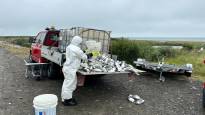In the most destructive area of the epidemic, Vesisaari, nearly 15,000 seagulls that died of bird flu have been collected. According to estimates, the number of dead seagulls may be more than double.
By Tuesday, 14,476 dead birds had been collected from the territory of Vesisaari municipality, says the chairman of the municipality Wenche Pedersen on Facebook. According to Pedersen, the municipal employees who collect carcasses have noticed that the number of sick and dead birds has decreased.
No one knows the real number of dead birds, and the number may well be more than double compared to those collected dead, i.e. more than 30,000 birds in the Vesisaari region.
Dead birds have been collected from places where sick birds have gathered in hundreds of flocks. Such places are the mouths of small rivers near Vesisaari.
Even healthy seagulls drink fresh water from streams and estuaries. It has been speculated that birds suffering from fever and neurological symptoms are left powerless and crying by the side of fresh water in their thirst. Sick birds cannot run away from humans.
Almost all the dead little kajavia
A week ago, more than 6,000 dead carp were collected at Storelva in Vesisaari. When we visited the place then ‘s photographer Elina Ervastin there were hundreds of dying and dead small kajavi, which were collected by the municipal workers in protective equipment to be disposed of.
Almost all seagulls killed by the virus are small seagulls. In the municipality of Vesisaari, there is a colony of tens of thousands of little terns on the cliff road of Ekkerøy, which is also popular with Finnish bird watchers. Time will tell how much of the little sable colony has died.
The Norwegian authorities have banned access to several birding sites in Finnmark to prevent the spread of the disease. On Ekkerøya, which is in the grip of an epidemic, movement is not prohibited, but it is recommended to avoid it so that the virus does not spread to other areas.
Access to the bird islands of Hornøya and Reinøya, which are popular with Finns off Vuoreija, is currently prohibited.
Other closed birding sites in the area of Tromssa and Finnmark are hundreds of kilometers further west in Andotten in the municipality of Hasvik and Eidvågen in the municipality of Hammerfest.
It is not known how the epidemic will continue
The regional director of the Food Safety Authority (Mattilsynet) interviewed by Norwegian Broadcasting Corporation NRK Finnmark By Arnt Inge Berget according to it is difficult to know whether the peak of the bird flu epidemic has been reached. Recently, the disease has also been found in the southern part of the coast of the provinces of Finnmark, Tromssa and Nordland.
The bird flu has so far been the worst in Northern Norway, in Eastern Finnmark, precisely in the Vesisaari area.
Almost all of the birds killed by the highly pathogenic H5N1 avian influenza virus, which causes a severe form of the disease, are little kajavas, which is a gull the size of a laughing gull.
So far, individual infections have also been found in other birds, such as sea eagles that prey on seagulls. Mammalian infections have been found in red foxes. The bird flu virus does not breed in fur farms because Norway banned fur farms in 2019. There are no fur farms in Finnmark today.
Norway does not limit hunting due to bird flu for the time being
For the time being, waterfowl and hen hunting in Norway will not be restricted for the coming autumn. According to the Norwegian Environmental Agency (Miljødirektoratet), there is no reason for the restriction, because no game bird species have been infected this year.
The game species mentioned by the agency are mallard, cormorant, short-billed goose, sea goose, tufted grebe, great grebe, mallard and crows.
